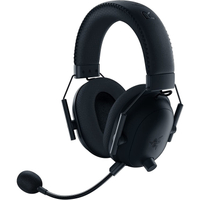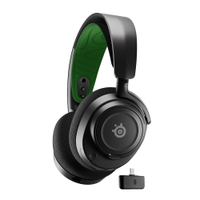The HyperX Cloud III Wireless offers a solid blend of excellent build quality and reasonable audio performance to provide a decent overall experience. Its battery life is a particular highlight, and if you want serious endurance, there aren’t many better options available.
Pros
- +
Comfortable with a sturdy build
- +
Bass-heavy audio impresses in some games
- +
Class-leading battery life
Cons
- –
Weak software
- –
Microphone lacks some lower-end body
Why you can trust TechRadar We spend hours testing every product or service we review, so you can be sure you’re buying the best. Find out more about how we test.
One-minute review
The HyperX Cloud III Wireless cuts the cord on one of HyperX’s longstanding models and brings it into the twenty-first century, where wireless headsets seem to rule the roost. The big draw here is with its rated 120 hours of runtime, which is among the very best wireless headsets out there, and means you won’t be having to charge the Cloud III Wireless regularly.
Its bass-heavy audio and solid imaging make it an excellent choice for games, although it isn’t the best I’ve tested for music. There is spatial audio present, although that can be quite hit-and-miss. The same also goes for the NGenuity software which, while lightweight, offers only basic functionality compared to the competition.
The Cloud III Wireless is well-made, offering plush memory foam earcups and fantastic comfort for extended periods, so long as you adjust the headset correctly. Its mic is clear for communication over Discord or conferencing apps, and while it lacks the overall richness of features compared to other options from SteelSeries and Razer, this remains a competent choice.
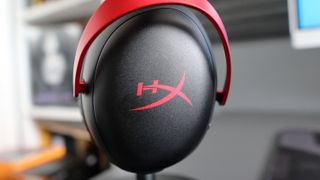
Price and availability
- $149.99 / £169.99 / AU$279
- Available in the US and UK
- Much better value in the US
Much like with the JBL Quantum 910X, the Cloud III Wireless is cheaper across the pond in the US than it is in the UK, being $149.99 and £169.99 in terms of retail pricing. That puts it in a similar ballpark to other class leaders such as the SteelSeries Arctis Nova 7X, with its $179.99 / £174.99 price tag, and while it’s slightly more expensive, you do get wider compatibility and connectivity options with Bluetooth, although HyperX’s competitor has a much longer battery life.
It’s also comparable in price to one of our favorite wireless gaming headsets, the Razer BlackShark V2 Pro, with its £179 / $179 price tag, and while the Cloud III Wireless is cheaper in the USA, it’s roughly equivalent in the UK, meaning this has got a lot to live up to. The Cloud III Wireless is also available in Australia at a price of AU$279.
Specs
Swipe to scroll horizontally
| Price | $149.99 / £169.99 |
| Weight | 11.6oz / 330g |
| Quoted battery life | 120 hours |
| Features | DTS Headphone:X spatial audio |
| Connection type | Wireless (USB-C/USB-A dongle), wired (USB-C) |
| Compatibility | PS5, PC, Nintendo Switch |
| Software | HyperX NGenuity (PC only) |

Design and features
The Cloud III Wireless is a signature headset from HyperX in terms of its design, carrying the same recognizable shapes as the brand’s previous entries. In fact, squint, and you might think you’re looking at the Cloud Alpha Wireless instead.
The most noticeable differences here compared to the Alpha Wireless are the lack of red stitching on the headband, and slightly angular earcups compared to the perfect ovals found on other headsets in the HyperX range. The Cloud III Wireless also comes with bright red aluminum forks, as well as speckled black and red wiring from the headband to the earcups, which looks excellent.
This is a well-made headset, with no creaks or odd noises from the plastic. Its headband and earcups are noticeably plusher than the Cloud Alpha Wireless, while the cups are deep, aiding comfort and also helping the Cloud III Wireless to provide some class-leading passive noise isolation. At 11.6oz / 330g, this sits in the middle of over-ear gaming headsets weight-wise and feels reasonably comfortable to wear for extended periods, although the slightly lighter clamping force can mean the Cloud III Wireless moves around on your head if not adjusted properly.
Luckily, this is a comfortable headset to wear for extended periods, once configured for your head properly. I had little trouble setting it up for hours of use and found the Cloud III Wireless to be one of the more comfortable headsets I’ve used, especially with those deeper earcups. There isn’t much room for adjustment around those earcups, however, as the Cloud III Wireless doesn’t fold flat, or offer much rotation there.
As with other HyperX headsets, the Cloud III Wireless features physical controls which are well-distributed across both earcups. The left-hand option features a power button and mic mute, as well as a USB-C port for charging and a place for slotting the detachable boom mic into. The right-hand side is home to a tactile and textured volume roller. Luckily, the buttons are different sizes, so it’s easy to find the one you want with ease.
While this headset solely connects via the bundled 2.4GHz receiver, it is at least quite a small option compared to other receivers which can be quite bulky and protrude out from a USB port on your PC, PS5, or Switch. The Cloud III Wireless’ receiver also boasts a detachable USB-A adapter alongside its initial USB-C connector, therefore improving compatibility.
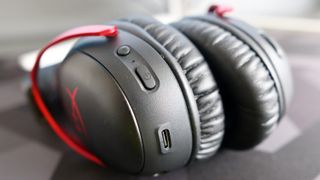
Performance
The Cloud III Wireless sounds superb in games with overall solid positioning in the likes of Counter-Strike 2 and other high-paced first-person shooter titles where finding the overall position of an enemy in time to pepper them with bullets is of top priority. In addition, engine notes in the likes of Forza Horizon 5 and F1 22 were clear, while explosions and gunfire in CS:2 had fantastic power thanks to the prominent low-end.
A word of advice – don’t enable the DTS Headphone:X spatial audio when listening to music, as it muddies the entire experience and can make some tracks sound as if they are being played from the next room, or down a loudspeaker. It is better with games, although only works in fully supported titles such as Forza Horizon 5. With games that don’t have full DTS Headphone:X support, the Cloud Wireless III has mixed results, occasionally spitting out a crunched-up mess as it attempts to process the signal. You’re better off leaving it off completely for the best performance.
As is typical for gaming headsets, the Cloud III Wireless has a lot of bass and this is particularly noticeable when listening to music. Rush’s Sweet Miracle offered plenty of low-end grunt, while Daryl Hall and John Oates’ Maneater presented more low-end than competing headsets, especially against Hall’s leading vocal on the verse lines.
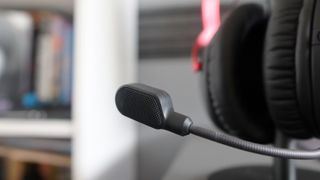
Mids and highs are clearer than the low end, with the Cloud III Wireless representing vocals especially well such as on James Taylor’s Caroline I See You, while the top-end hi-hats on Could You Be Loved by Bob Marley were bright and crisp. The Cloud III Wireless doesn’t offer the widest soundstage, as busier recordings such as Rush’s Sweet Miracle can feel hemmed in with this particular set, while the prominent bongos on Earth, Wind and Fire’s September feel closer to my right ear than on other similarly-priced headsets and audio-focused headphones.
The Cloud III Wireless’ boom microphone is clear, offering a good amount of body from its pickup in my testing, while its rejection of noise other than voices is also pretty good. Compared to other options though, it lacks some low-end so recordings can sound a little open-ended at the bottom, although the mid-range where your voice lives is more than adequate.
Connectivity over the 2.4GHz receiver is convenient, and I had no trouble pairing the Cloud III Wireless to my PC. It’s a simple case of plugging the receiver into a spare USB-C or USB-A port and turning the headset on. The Cloud III Wireless flashes a green LED, bleeps, and then connects. The same also went for use with my Nintendo Switch.
The main reason for purchasing the Cloud III Wireless over its rivals is its especially long battery life of up to 120 hours. It means that you won’t be charging this head for a good couple of weeks for more intensive use, and for longer if you’re using it less frequently. In my fortnight of testing the Cloud III Wireless, I only had to charge it once, and it otherwise chugged along nicely. For reference, the SteelSeries Arctis Nova 7X will only last for 38 hours between charges, while the Razer BlackShark V2 Pro only offers up to 24 hours, meaning this Cloud III Wireless has them both beat in terms of endurance.
Unfortunately, the Cloud III Wireless falls down with its software control. HyperX’s NGenuity software has never been the best option for peripheral controls, and that continues with the Cloud III Wireless. For a headset priced so optimistically against the competition, NGenuity feels cheap, only offering basic customization for picking an EQ preset or creating your own from a ten-band EQ. Otherwise, it provides toggle switches for mic monitoring and spatial audio, as well as volume control for the headset and microphone.

Should you buy the HyperX Cloud III Wireless?
Buy it if…
You want oodles of endurance
The Cloud III Wireless’ 120 hours of battery life is unmatched in its price category and isn’t bettered by many headsets that cost more, excluding HyperX’s own Cloud Alpha Wireless. If you want lots of runtime, this is the headset to go for.
You want lots of bass
If it’s lots of low-end you’re after, the Cloud III Wireless is the headset to go for in its price category. Other options tend to have a more refined overall sound but the Cloud III Wireless is a more fun option.
